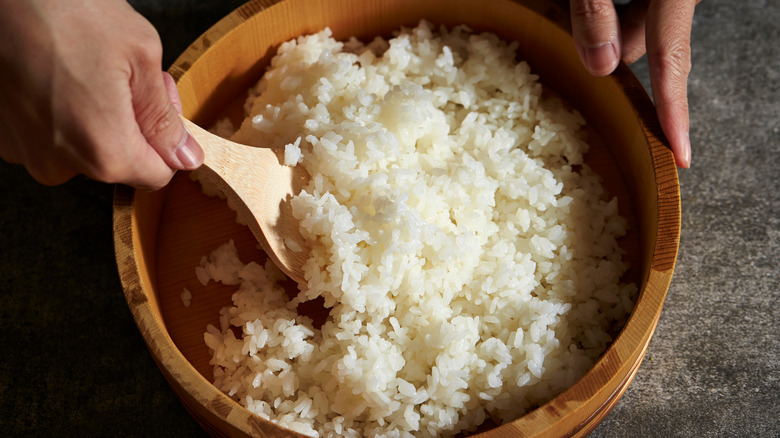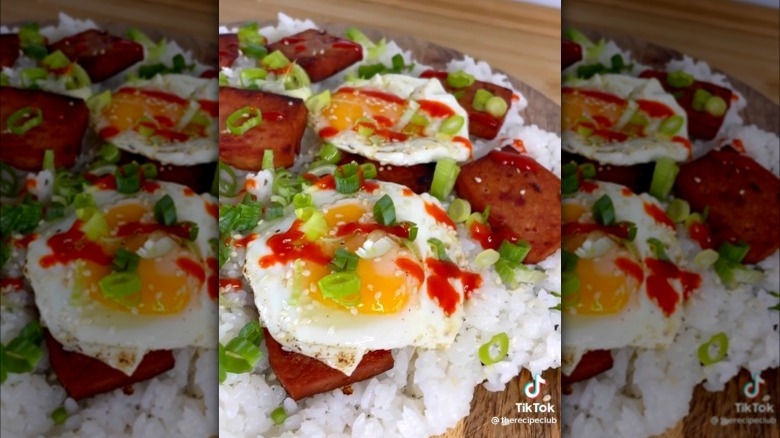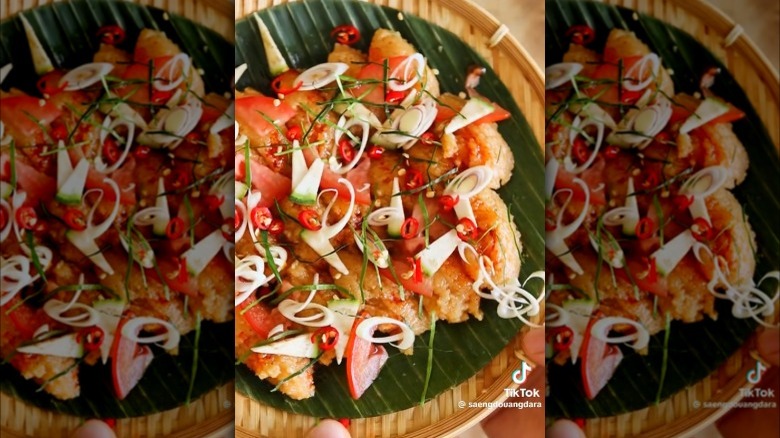Move Over Charcuterie Boards — Rice Boards Are Here For Better Dinner Parties
As your calendar fills with holiday entertaining events, you may be facing a weird dilemma: should you go with the classic charcuterie board or the trendy butter board for a shareable centerpiece? It may be a hot take, but we suggest you skip both of them in favor of the more revolutionary rice board. If you're new to the rice board, let us explain. This novel concept was first introduced in a TikTok video from Korean foodie Soo-Jin Kim.
@knowtoriously One year later, still prefer my board #notabutterboard #riceboard 밥보드
As shown in the video, Kim makes a batch of sushi-style rice, spreads it out on a board, and layers on some classic spam musubi toppings. Then, with nori seaweed working as a flexible kind of nacho, she grabs perfectly portioned bites of spam, rice, and sesame seeds before dipping them in some soy sauce. Not only is the recipe considerably less fussy than a traditional charcuterie or butter board, but it's also decidedly cheaper too. So how should you get started on making your own rice board for a festive feast?
How to make your own rice board
As with the butter board phenomenon, the base layer is the most important ingredient. For a classic rice board, seasoned sushi rice is your best bet. This short-grain rice cooks into a mildly sticky mixture, making it easier to pick up good chunks with utensils. It will also taste better if you give it a traditional dash of seasoning, adding a bit of sugar, soy sauce, and seasoned rice vinegar for a punch of flavor. As for the display, make sure to cover whatever board you are using with a bit of parchment paper, as the glutinous exterior of the rice will be prone to sticking to the wood and plastic surfaces.
Traditional toppings skew toward the rich and salty, as the base of plain sushi rice tends to complement these ingredients. For meats, consider using salty cured ingredients like Spam, Chinese sausages, Canadian bacon, or even bologna. For decadence, place a few fried eggs (runny yolks, please) or some scrambled curds on the rice board as well. All other ingredients should be there to enhance the overall flavor or add a bit of texture, like toasted sesame seeds, sliced green onion, and pickled radish.
To scoop from the board, use nori sheets and/or chopsticks — again, the sticky nature of the rice will help you with the grabbing. And don't forget the sauce bowls. A trio of soy sauce, sriracha, and ponzu sauce would be a nice touch.
Variations on a rice board
Like a butter board, the rice board is a very flexible medium for culinary creativity. For seafood fans, the rice board easily translates over to a unique way to display some raw sashimi. Layer on slices of raw salmon, tuna, or scallop and drizzle it with a bit of soy sauce, sriracha, and/or hoisin sauce. Make it California roll style by incorporating avocado, imitation crab, and crunchy cucumber, or heap on dollops of cream cheese and slices of smoked salmon for a Philly roll take. You can even use the nori pinch-and-eat method or the chopstick method for eating.
You can also get ideas for the rice board by taking it in the poke bowl direction. Cube your favorite raw fish or cooked protein (dealer's choice) and add in some classic accompaniments like edamame, mango, seaweed salad, and shredded carrots. A spicy mayo would work nicely as a topping as would a crowd-pleasing scoop of thick ponzu sauce. Basically, any concept that begins with sushi rice as a base can be transformed into a delectable rice board.



